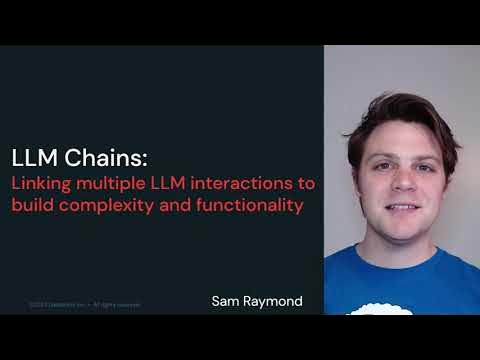What is LangChain? 101 Beginner's Guide Explained with Animations
Summary
TLDRThe video script delves into LangChain, a framework that simplifies the development of applications using large language models. It discusses the evolution from a Python package to TypeScript and Ruby ports, emphasizing LangChain's ability to handle complex tasks involving data integration and model actions. The script explores components like document loaders, text splitters, vector databases, and prompt templates, illustrating how they streamline interactions with language models. It also touches on the importance of semantic search, embedding models, and the use of chains and agents to create dynamic, stateful applications, hinting at the vast potential of this emerging technology.
Takeaways
- 🔥 LangChain is a popular framework for developing applications on top of large language models, addressing the complexities beyond simple API requests.
- 🔧 It started as a Python package but has TypeScript and Ruby ports, aiming for feature parity and expanding accessibility.
- 📈 LangChain simplifies tasks by chaining components to handle data from various sources and execute actions, making it easier to swap models or databases.
- 🔍 The framework supports models like language models and text embedding models, which are crucial for semantic search and understanding text in a vector space.
- 📝 Prompts are essential for guiding the input to language models, with LangChain offering prompt templates for flexibility and structured input.
- 📚 Few-shot learning is facilitated by providing examples to prompts, helping to shape the model's output with a given set of data.
- 🔑 Output parsers are used to automatically structure the language model's output into objects, making it easier to handle and interpret.
- 🗂 The indexes module allows for the use of personal data with document loaders and text splitters, enabling the integration of diverse data formats.
- 🔎 Vector databases are integrated with LangChain for storing and retrieving embedded documents, supporting semantic search capabilities.
- 🔗 Chains in LangChain abstract model calls to language models, handling prompt formatting, model interaction, and result retrieval in a stateless manner.
- 🤖 Agents in LangChain, though not detailed in the script, are mentioned as a higher-level concept that will be explored further, indicating a potential for more complex interactions.
Q & A
What is LangChain?
-LangChain is a framework used to develop applications on top of large language models like GPT, Llama, and Hugging Face models. It started as a Python package and now has a TypeScript port and a Ruby version in development.
Why is LangChain needed?
-LangChain is needed because it simplifies the development of complex applications that involve connecting language models to various data sources and making them perform actions like sending emails, searching the web, or running code. It provides components that handle these tasks, making the process less messy and repetitive.
What are some of the components LangChain offers?
-LangChain offers components such as document loaders, text splitters, vector databases, prompt templates, and tools for actions like sending emails. These components help in loading, processing, and managing data for language models.
What are the two types of models in LangChain?
-The two types of models in LangChain are language models and text embedding models. Language models take text as input and return text, while text embedding models convert text into arrays of numbers for use in vector spaces.
What is semantic search and how is it used in LangChain?
-Semantic search is a technique that finds pieces of text most similar in meaning to a given input within a vector space. LangChain uses text embedding models to create these vector representations, enabling semantic search over the stored data.
How does LangChain handle prompts?
-LangChain provides the prompt template class to construct prompts using multiple values. It supports various use cases like few-shot learning and output parsing, enhancing the flexibility and readability of prompts.
What is few-shot learning in the context of LangChain?
-Few-shot learning in LangChain involves providing the model with a few examples to guide its output. This is done by creating a list of examples, formatting them with a template, and using the few-shot prompt template object.
What is the purpose of output parsers in LangChain?
-Output parsers in LangChain automatically structure the output from language models into defined objects, making the results more useful and organized. For example, they can parse the output into joke objects with specific fields like setup and punchline.
What are indexes in LangChain, and how are they used?
-Indexes in LangChain refer to methods of loading and managing data. The indexes module provides document loaders for various formats, text splitters to chunk large texts, and integrations with vector databases for storing and retrieving embedded text.
What is the difference between stateless and stateful operations in LangChain?
-Stateless operations in LangChain do not remember previous interactions, while stateful operations use memory to maintain context across interactions. For example, conversation chains use memory to handle ongoing dialogues, making them stateful.
Outlines

Этот раздел доступен только подписчикам платных тарифов. Пожалуйста, перейдите на платный тариф для доступа.
Перейти на платный тарифMindmap

Этот раздел доступен только подписчикам платных тарифов. Пожалуйста, перейдите на платный тариф для доступа.
Перейти на платный тарифKeywords

Этот раздел доступен только подписчикам платных тарифов. Пожалуйста, перейдите на платный тариф для доступа.
Перейти на платный тарифHighlights

Этот раздел доступен только подписчикам платных тарифов. Пожалуйста, перейдите на платный тариф для доступа.
Перейти на платный тарифTranscripts

Этот раздел доступен только подписчикам платных тарифов. Пожалуйста, перейдите на платный тариф для доступа.
Перейти на платный тарифПосмотреть больше похожих видео
5.0 / 5 (0 votes)






